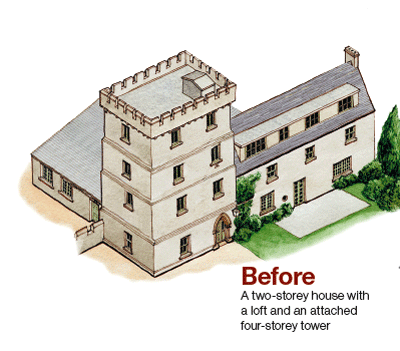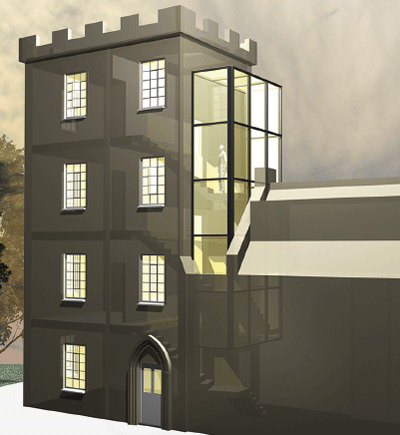Dream House week six: Young talent
This week young architecture Charles Page grapples with the problems of circulation and lighting in a tower house

Ptolemy Dean on the existing house

What could be more romantic than living in a tower? With every Englishman's home his castle, the tower embodies security and safety, combined with good views over distant landscapes.
Although it looks more like something from the Welsh or Scottish borders, where fortified houses were essential for many centuries, this house is in fact located in southern England, and is constructed from attractive, creamy grey limestone. There is a Victorian character to it, but it's attached to a much older-looking house, built to one side. The function of this tower appears to be more ornamental than defensive.
Inevitably with towers, the main staircase has to be located within the footprint of the tower itself, leaving whatever floor space is left on each floor of the tower to provide a single room. This tower has four floors, suggesting a life that is consequently centred around the staircase that connects them. In order to make the most of the limited area of floor available on each level, the staircase has been made as narrow as possible, and as it's located on the side of the tower, which is abutted by the rest of the house, it has few windows and looks to be quite dark. This must make the transition between the floors a somewhat forbidding and depressing process.
Almost in compensation for this, the ground-floor plan of the house appears to have been extended significantly at the back, and now sprawls across a wide area at ground-floor level. It is almost as if the upper floors of the tower are now surplus to requirements. Upstairs, there are corridors or walk-through rooms to connect the staircase with the more distant parts of the house.
The brief for this house was, therefore, to see whether the quality of space and light within the building could be improved, and the experience of living in this tower provided with increased delight
Charles Page on his vision
Sign up for the Country Life Newsletter
Exquisite houses, the beauty of Nature, and how to get the most from your life, straight to your inbox.
The brief presented one challenge above all others: the need to inject more light into the house as a whole. The proposal addresses this, and attempts to solve a further complexity with the existing layout: its circulation.
As it is, the rooms to the back of the house represent a series of confused spaces, with no logical connection. Circulation is a vital part of how we experience a building-it should not be seen simply as a way to pass from A to B.
In this proposal, the rear of the house is simplified, introducing a wide east-west axis with bookshelf-flanked walls (labelled library) and a new roof light to allow natural light to penetrate into the heart of the house. The existing north-south axis will remain.
These same themes drive the plans' major intervention. It was critical to improve the entrance to the house- currently, a narrow stairwell-and turn it into a space that is both fitting of such a house and one that celebrates the language of the existing tower
A new light well climbing right up to the top of the tower is encircled by a stair that punches through the existing external wall. The stair is partly accommodated by a new glass tower that juxtaposes the solidity of its stone neighbour. It represents a contemporary take on the tower- all light and transparency-without detracting from the original. The result is a proposal where light and circulation give the building, and the way in you move through it, a sense of excitement and clarity.
After

Ptolemy's verdict
Charles Page is a recent graduate of the Edinburgh and Westminster University Schools of Architecture, and, consequently, his solution to this building is fresh and radical. His solution confronts head on the central problem of this house: its restricted and gloomy staircase. But rather than enlarge the staircase within the tower, which could have significantly diminished the size and proportion of the tower rooms themselves, he has instead burst out of the side of the tower with a glazed addition.
This contains a new and enlarged staircase. Ascending this new stair, users will pass through the thick defensive wall of the tower with all its solidity and sense of security, and then find themselves rising within the glass addition for a flight or two, perhaps sensing some feeling of drama and vulnerability as the inherent safety of the main tower is left.
The handrail of the stair is glass, too, so this will not be a stair for those who suffer vertigo. Then, back round into the old tower and so on as the stair makes its way up the building. The new stair is lit by a glass roof, as is the section of stair within the old tower, so there will be a sense of flooding sunlight and shafts of shadow by day; by night, users will be able to gaze up at the stars. Looking at this staircase, one almost wishes it extended all the way up to the roof, so that the air and aspect could be thoroughly enjoyed after so exhilarating an ascent.
By introducing so much daylight into this staircase, the passageways and through rooms of the old house will also be animated, to the extent that this new stair will form a bright heart to this otherwise dark house
Country Life is unlike any other magazine: the only glossy weekly on the newsstand and the only magazine that has been guest-edited by HRH The King not once, but twice. It is a celebration of modern rural life and all its diverse joys and pleasures — that was first published in Queen Victoria's Diamond Jubilee year. Our eclectic mixture of witty and informative content — from the most up-to-date property news and commentary and a coveted glimpse inside some of the UK's best houses and gardens, to gardening, the arts and interior design, written by experts in their field — still cannot be found in print or online, anywhere else.
-
 Six rural properties with space, charm and endless views, as seen in Country Life
Six rural properties with space, charm and endless views, as seen in Country LifeWe take a look at some of the best houses to come to the market via Country Life in the past week.
By Toby Keel
-
 Exploring the countryside is essential for our wellbeing, but Right to Roam is going backwards
Exploring the countryside is essential for our wellbeing, but Right to Roam is going backwardsCampaigners in England often point to Scotland as an example of how brilliantly Right to Roam works, but it's not all it's cracked up to be, says Patrick Galbraith.
By Patrick Galbraith